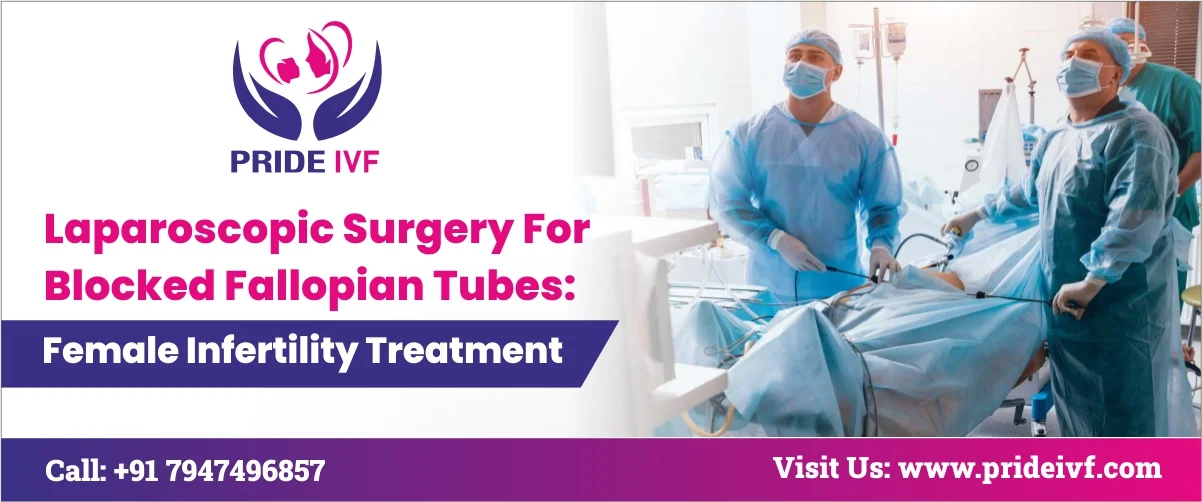Achieving your pregnancy dream is a challenging procedure, especially when you have infertility complications. Infertility, in general, may impact your life drastically, restricting you from parenthood. In such circumstances, medical advancements bring a ray of hope into your life.
One of the most technologically advanced medical procedures for pregnancy is laparoscopic surgery. Welcome to this comprehensive guide, where you can get the details on laparoscopic surgery for blocked fallopian tubes or tubal blockage.
Among other types of infertility issues, fallopian tube blockage is common. Fallopian tube obstruction is a condition where the path for sperm to reach the eggs is blocked. While it doesn’t cause any symptoms, some women experience mild or severe pain during intercourse or the menstruation cycle. Consult the International Pride IVF Centre in Delhi for laparoscopic surgery for blocked fallopian tubes.




Laparoscopy, In a Nutshell: Understanding the Symptoms and Causes
Laparoscopic surgery is minimally invasive and includes small incisions from where small incisions and operating instruments are inserted into the pelvic bone. It helps diagnose the causes of infertility and is the ultimate solution when other infertility tests cannot evaluate the condition.
Laparoscopy is used for treating fallopian tube obstructions, endometriosis, and pelvic scar tissue. The causes of female infertility with tubal blockage include the following:
- Pelvic infections like gonorrhoea and chlamydia
- Endometriosis occurs when tissues lining the uterus grow outside
- Pelvic surgery like C-section
- Ectopic pregnancies
- Previous treatments or surgeries, like radiation therapy
- Abnormality in the structure of tubes from birth
Everything to Know about Laparoscopy Treatment for Tubal Blockage: How Does It Work?
The prime objective of laparoscopic surgery for blocked fallopian tubes is to diagnose and treat blockage in fallopian tubes in a single procedure. The patient remains under anaesthesia when a small camera and a thin tube are placed through the incision. It offers the surgeon a video feed with magnified views of the tissues. What it does is offer the surgeon a better view of the female reproductive system.
Two small incisions are placed above the pelvic region and toward the left side of the abdomen. It helps investigate the root causes of blocked fallopian tubes by assessing the condition of the ovaries, fallopian tubes, and the womb. After the gas is inflated to the abdomen, the doctor gets a better view of the organs. A dye is injected to determine the condition of the fallopian tubes.
Fallopian tubes blocked proximally have the greatest chances of opening using conventional treatment. Medical practitioners recommend the procedure where they insert a catheter via the womb into the tube. A balloon is used for opening the tube.
Also Read: How To Open Blocked Fallopian Tubes?
The next type of blockage is placed medially, which is harder for doctors to evaluate. Medical professionals recommend laparoscopic surgery, where adhesions are cauterised. The tube is then cut and re-joined. However, it’s complicated, and scar tissues may grow or block the tube. Thus, the success rates are not as high as the previous type.
Fallopian tubes blocked distally are the hardest to treat. Since the blockage is situated close to the delicate fimbria, a doctor might not be able to eliminate adhesions without damaging the fimbria. In addition, the area tends to become harder in case adhesions grow again, thereby covering the ovary. In such circumstances, doctors usually recommend IVF.
Lets get started
Top Laparoscopic Surgeries for Blocked Fallopian Tubes: What Do You Need to Learn?
Blockage in the fallopian tubes may obstruct the sperm from passing and penetrating into the egg. It may also prevent a fertilised egg from transferring to the womb. A doctor corrects such a condition by identifying the root causes. The medical expert may recommend laparoscopic surgery depending on the extent and location of the blocked fallopian tube.
The surgeon uses microsurgical techniques to use laparoscopy and conduct the surgery using a tiny incision. The trained expert leverages advanced technology to offer the best blocked fallopian tube treatment. The success rate of laparoscopic surgery is high when compared to other treatments.
Fimbrioplasty
It’s one of the best methods to restore the fallopian tubes and their integrity. Women who face pregnancy issues can consider consulting a doctor regarding fimbrioplasty. If the pregnancy issue results from a blockage in the fallopian tube area close to the ovary, your doctor may recommend a fimbrioplasty operation.
Tubal Cannulation
Next comes tubal cannulation, which is an ideal female infertility treatment for conditions where the tubal blockage occurs next to the womb. Tubal cannulation is a nonsurgical process that uses hysteroscopy and laparoscopy. The doctor inserts the cannula or catheter through the cervix and uterus into the tube to reopen the blockage.
Tubal Reanastomosis
The last one is tubal reanastomosis, which repairs one portion of the fallopian tube (damaged due to a disease). The blockage is removed, and healthy portions are re-joined for spontaneous pregnancy. Its success rate is higher than that of any other treatment, including IVF.
Conclusion
Get the best treatment from the experts at pride ivf working at this top-notch clinic. This infertility clinic is committed to offering holistic and technologically advanced infertility treatments for both men and women.




